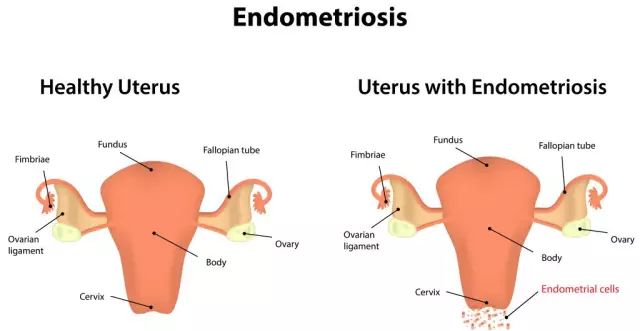- Author Rachel Wainwright [email protected].
- Public 2023-12-15 07:39.
- Last modified 2025-11-02 20:14.
Endometriosis

Endometriosis is a disease of the female reproductive system in which the mucous tissue normally lining the inner cavity of the uterus, called the endometrium, grows where it is unusual for it to be.
The endometrium is a special type of mucous tissue. During the cycle, it increases in size, and then is rejected and removed from the body. This process is called menstruation and is controlled by hormones. The endometrium, located where it is not supposed to be, is also subject to the action of hormones. During the first phase of the cycle, it increases, then begins to bleed and try to be rejected, but the exit of the rejected tissue in this case does not exist. Endometriosis leads to the formation of cysts and adhesions in the foci of the endometrium, and they tend to grow every month. They disrupt the anatomical position of organs, and are one of the most common causes of female infertility.
Endometriosis causes
The main cause of endometriosis is the migration of endometrial cells to where they should not be. The mechanism that causes such a migration is not known for certain, but it has been found that there may be several reasons:
- Congenital structural anomalies, including the mucous membrane of the uterus. Endometriosis in rare cases develops even in young girls before the onset of menstruation, and also, extremely rarely, but still occurs in men. These facts, as well as the fact that endometriosis is often accompanied by other developmental anomalies, indicate that violations can occur during intrauterine organ laying;
- Mechanical introduction of endometrial cells into unusual places during trauma to the female genital tract. This happens during diagnostic curettage, gynecological operations, abortion and during manual examination of the uterine cavity after childbirth;
- Cauterization of cervical erosion.
In some cases, it is not possible to establish the exact cause of endometriosis.
In addition to the above, predisposing factors play a role, without which the formation of endometriosis does not occur even in the presence of migrating endometrial cells. These can be disorders of the immune system, endocrine (hormonal) disorders, as well as chronic diseases of the organs of the female reproductive system.
Types of endometriosis
Normally, the endometrium is located exclusively on the inner surface of the uterus. Depending on where exactly the migrated endometrial cells settled and germinated, there are different forms of endometriosis:
- Genital endometriosis. Areas of endometriosis are located on the organs of the reproductive system. In turn, it is divided into internal, when the endometrium grows into the deep layers of the uterus (adenomyosis), and external, when the fallopian tubes, ovaries, cervix, vagina can be affected by endometriosis;
- Extragenital endometriosis. With this type of endometriosis, the nodes characteristic of it can be located in any organs, where they can be brought with the flow of blood or lymph. Their most frequent location is the peritoneum, rectum, bladder, that is, organs adjacent to the uterus.
Endometriosis symptoms

The most characteristic signs of endometriosis are rather intense painful sensations during menstruation, and sometimes, in the case of a significantly developed process, pain during intercourse. Also, the characteristic symptoms of endometriosis include the appearance of dark spotting before and after menstruation. However, the listed signs of endometriosis are not required, and are more characteristic of genital endometriosis.
Extragenital endometriosis symptoms can be very far from gynecological diseases. As a rule, it is also pain in the foci of endometriosis, but since the foci in this case are not located in the genitals, this can be misleading in diagnosis. Nevertheless, in all cases of the appearance of symptoms of endometriosis, their dependence on the phase of the menstrual cycle is traced. In the second phase, as you get closer to your period, endometriosis symptoms increase as the endometrium grows. In the first phase, signs of endometriosis are minimal. When menstruation stops due to pregnancy or lactation, the symptoms of endometriosis may disappear and return when they appear.
In a significant percentage of cases, there are no signs of endometriosis at all. In this case, as a rule, it is discovered late, the first to attract attention is the developed cystic and adhesions process. Most often, this "silent" type of endometriosis is found during examination for infertility.
Endometriosis diagnosis
Diagnosis of endometriosis can be difficult, especially in the case of an extragenital location. The following diagnostic measures are carried out:
- Gynecological examination;
- A blood test (as a rule, signs of anemia are found);
- Hysteroscopy - endoscopic examination of the uterine cavity;
- Hysterosalpingography - X-ray examination of the uterus and fallopian tubes using a radiopaque substance;
- Laparoscopy, endoscopy of the abdominal cavity to detect extragenital foci of endometriosis;
- MRI, or magnetic resonance imaging, which can detect both genital and extragenital endometriosis.
Endometriosis treatment
Treatment of endometriosis depends on the stage of the process, the location and size of the lesion. Taking into account all these factors, medical or surgical treatment of endometriosis, or a combination thereof, is prescribed.
Medical treatment of endometriosis consists in the use of hormonal drugs, anti-inflammatory therapy, taking absorbable agents, as well as carrying out general strengthening and immunostimulating measures. If there are signs of anemia, substances are also prescribed to help eliminate it.
If drug therapy was unsuccessful, and also when endometriosis contributes to significant blood loss with the development of severe forms of anemia, as well as in the presence of complications of endometriosis, namely cysts and adhesions that disrupt the normal activity of organs, surgical treatment of endometriosis is undertaken. As a rule, it is carried out by the laparoscopic method, and consists in eliminating the neoplasms that have arisen, restoring the normal anatomical position of the organs, and removing foci of endometriosis.
Alternative treatment of endometriosis

Alternative treatment of endometriosis consists in the use of herbs as a fortifying, anti-inflammatory, hemostatic agent. Such herbs include St. John's wort, chamomile, calamus, thyme (anti-inflammatory), stinging nettle, water pepper (hemostatic), aloe, echinacea (fortifying).
Also, honey and beekeeping products are used as a folk treatment for endometriosis, which are an excellent natural immunostimulant.
However, alternative treatment of endometriosis should be carried out only under medical supervision.
YouTube video related to the article:
The information is generalized and provided for informational purposes only. At the first sign of illness, see your doctor. Self-medication is hazardous to health!






